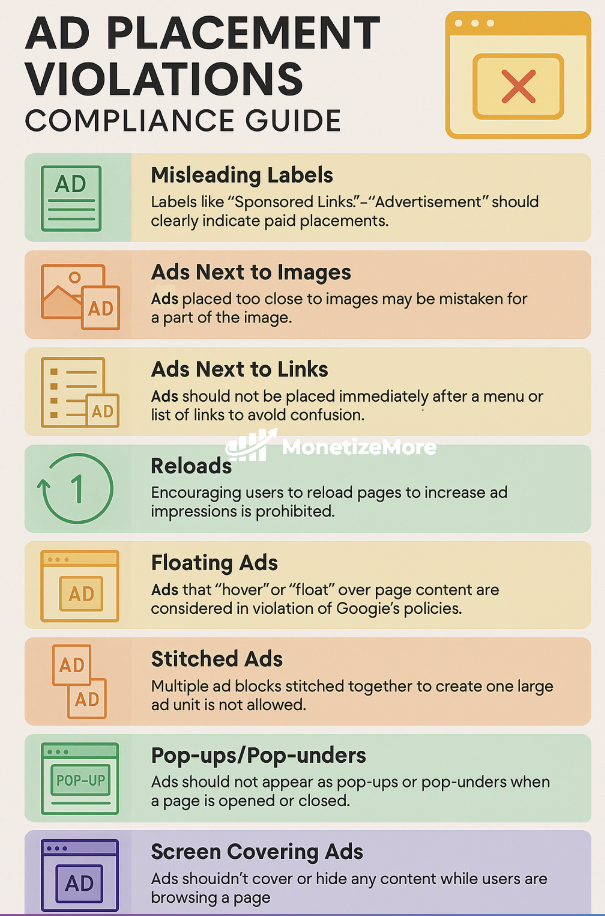Ad placement violations can significantly impact user experience, revenue generation, and compliance with Google’s policies. Below is an in-depth explanation of each violation, providing clarity on what publishers should avoid and how to stay compliant.

Misleading labels occur when ads are not clearly identified as paid placements. Using vague terms like “Sponsored Links” or blending ads into content without proper labeling confuses users, leading to accidental clicks and policy violations.
Best Practices:
Placing ads too close to images can mislead users into thinking the ad is part of the image or related content. This practice violates Google’s policies as it encourages accidental clicks.
Best Practices:
Ads placed immediately after menus or lists of links can create confusion, making users think the ad is part of the navigation structure. This leads to unintentional clicks and disrupts user experience.
Best Practices:
Encouraging users to reload pages repeatedly to inflate ad impressions is a deceptive practice that violates advertising policies and harms user trust.
Best Practices:
Floating ads hover over page content, obstructing visibility and navigation. These intrusive placements frustrate users and violate compliance standards for non-disruptive advertising.
Best Practices:
Stitched ads combine multiple ad blocks into one large unit, creating cluttered layouts that overwhelm users and reduce site usability.
Best Practices:
Ads appearing as pop-ups or pop-unders disrupt browsing sessions by covering content or triggering unexpected windows when pages are opened or closed.
Best Practices:
Ads that cover or hide page content while users browse create frustration and diminish trust in the site’s usability, violating Google’s guidelines for non-intrusive advertising practices.
Best Practices:
Violating Google’s ad placement policies can lead to severe penalties for publishers and advertisers. As of the latest updates, here are the key consequences for non-compliance:
Upon detection of significant violations, Google may suspend the offending Google Ads account immediately without prior warning. This includes both serious violations and repeated minor infractions, emphasizing a zero-tolerance approach to non-compliance.
In cases of severe or sustained policy violations, accounts can be permanently banned from advertising on Google platforms. This means that once banned, the account holder will lose all privileges associated with Google Ads and cannot create new accounts.
Publishers and advertisers who violate policies may also face removal from Google’s third-party programs, such as Google Partners. This can significantly impact their ability to leverage Google’s advertising ecosystem and reach potential audiences.
Violators may lose specific privileges associated with their accounts, including access to promotional discounts and other benefits Google provides to compliant partners.
Once a violation occurs, Google may subject accounts to increased scrutiny and monitoring. This could result in more frequent audits and checks for compliance, making it harder for the account holder to operate like they usually do.
If a publisher works with third-party agencies or partners that violate Google’s policies, these violations can also affect the publisher’s account status. The responsibility for compliance extends to all partners involved in the advertising process.
In addition to losing advertising privileges, publishers may also face financial repercussions due to lost revenue from suspended ads or reduced visibility in search results due to policy violations.
Use this checklist to stay compliant:
| Category | Details | Fixes |
|---|---|---|
| Ad Placement | Ensure ads do not obstruct content or interfere with navigation | Place ads in non intrusive locations; clearly label them |
| Transparent Labels | Use terms like “Advertisement” or “Sponsored.” | Avoid ambiguous labels; ensure visibility |
| Navigation | Maintain intuitive site structure | Fix broken links; avoid excessive pop-ups |
| Page Speed | Optimize loading speed for ads | Use lightweight ad formats |
| Content Quality | Provide unique, valuable content | Avoid thin articles; update content regularly |
Non-compliance with ad placement policies not only risks penalties but also damages user trust and engagement. Publishers who prioritize transparent, non-intrusive ad placements foster a better browsing experience while maximizing revenue potential.
Publishers and advertisers must adhere strictly to Google’s ad placement policies to avoid these severe penalties. Regular audits of ad placements, clear ad labeling, and compliance with content guidelines are essential to avoid revenue clawbacks and ad account bans. Want us to protect your ad account? Get started here!

With over ten years at the forefront of programmatic advertising, Aleesha Jacob is a renowned Ad-Tech expert, blending innovative strategies with cutting-edge technology. Her insights have reshaped programmatic advertising, leading to groundbreaking campaigns and 10X ROI increases for publishers and global brands. She believes in setting new standards in dynamic ad targeting and optimization.
10X your ad revenue with our award-winning solutions.